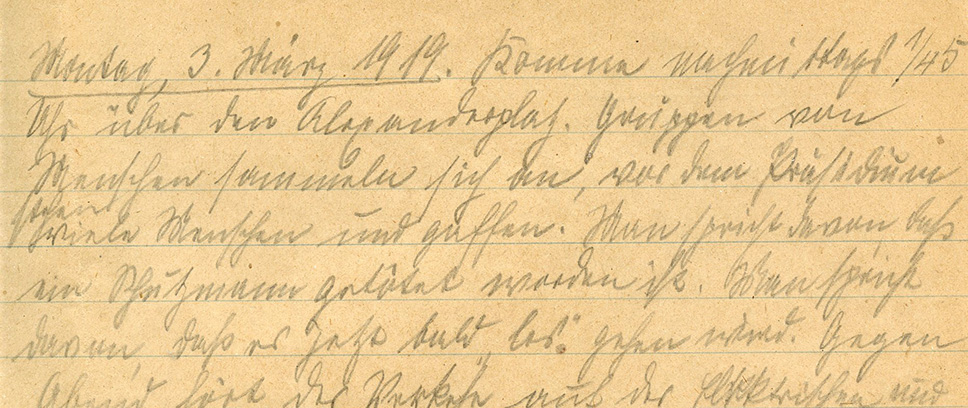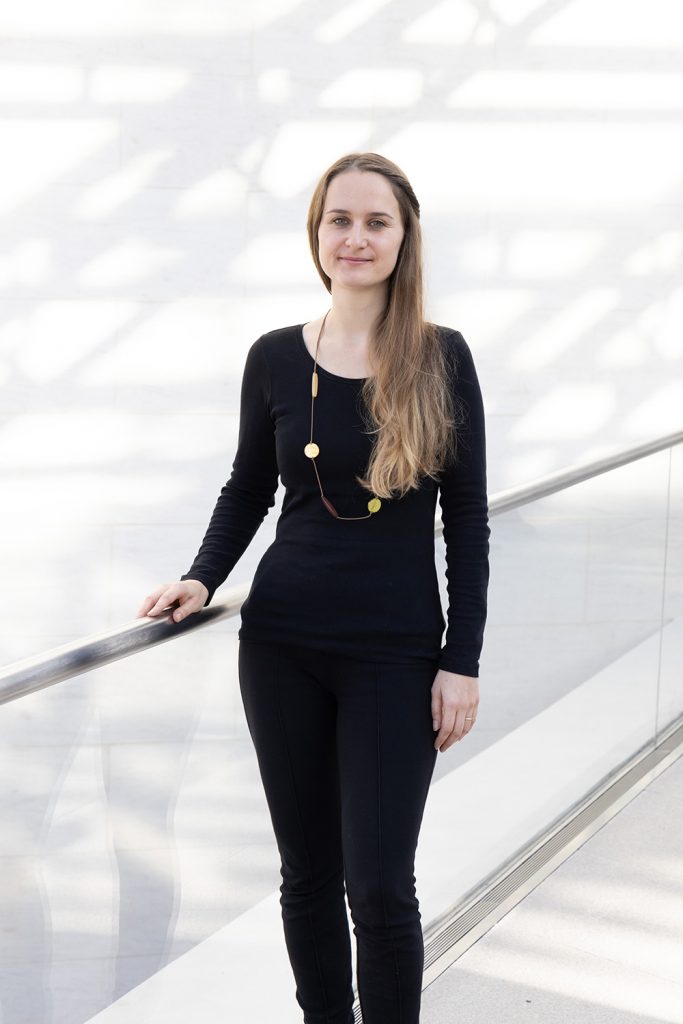
“Barricade Heroes” and “Bloodhounds” – The diary of a young Berlin woman on the March Battles of 1919
Lisa Sophie Gebhard | 22 March 2022
In the winter of 1919, bloody barricade fighting broke out in Berlin, which went down in history as the “Berlin March Battles”. The diary entries of a young eyewitness throw light on the violent rioting in the final phase of the German November Revolution from a female perspective. The impressive document, which was taken into the DHM collection 102 years later, is presented here by the academic trainee Lisa Sophie Gebhard.
The third day of March was a cloudy, rainy Monday in Berlin. As the 19-year-old student Hedwig Rosen was crossing Alexanderplatz in the afternoon, crowds were gathering in front of the police headquarters in Alexanderstrasse. “People are saying that it’s going to break out soon,” she then wrote in her first diary entry. In fact, a general strike of the Berlin workforce began on this Monday, which in the following days was to lead to brutal conflicts between police and government troops on the one side and followers of the KPD, the Communist Party of Germany, on the other. The strikers hoped to establish a “Räterepublik”, a Soviet-style republic with workers’ councils, following the democratic elections for the National Assembly.
After a rebellion of the radical leftist Spartacists, named after their illegal press organ “Spartacist Letters”, had been violently crushed by the Freikorps militias in January 1919, the prospects for this aim were very slim. The leading thinkers of the KPD, Karl Liebknecht and Rosa Luxemburg, had already been murdered, and other prominent representatives such as Leo Jogliches were in remand prisons.
When the March Battles began, Hedwig Rosen was living with her parents and three siblings in Alexanderstrasse 30.[1] The residence where the Rosens lived was centrally located opposite the police headquarters, which the Berliners had nicknamed “Red Castle” because of the red brick façade. In the next days, there were particularly severe riots near the headquarters, in which a prison was located. There, Hedwig Rosen and her family were involuntarily in the line of fire; she recorded authentic descriptions of the events.
After a state of emergency had already come into effect in Berlin on 3 March, the general strike was finally crushed on 8 March, but adherents of the KPD, who had been dismissed out of hand as “workshy riffraff” and a “Spartacist robber band”[2] in the widely circulated Berliner Tageblatt, attempted to continue the strike. They fought bloody battles with the Guard Cavalry Division, a major formation of the Prussian Army, which was charged with suppressing the riots.
Rosen’s diary relates that their house was occupied by Spartacists on 5 March. She describes how a “troop of sailors with loaded guns, hand grenades and one machinegun” took up position in the gateway of their house. All night long, she writes, the machinegun shots roared, interrupted by a spotter plane that was fired at by the Spartacists as they cheered and whistled.
On the next day, artillery and mortars could be heard, and window glass came crashing down. For fear that the house could collapse, the family fled to the back of the flat. Wounded Spartacists banged on the door, one with a lung shot, and begged for help. “Heartbreaking”, writes Rosen, “was the screaming and groaning of the wounded man in front of our door. He threw cartridges at the door to get our attention. We could not help him and were not allowed to.” Rosen’s father, who had sworn the Hippocratic Oath as a doctor, must have struggled with his conscience. On the next morning, two dead bodies lay in the front courtyard.

For Rosen it was the “hour of salvation” when the government troops finally moved in. She felt pity towards the injured Spartacists but most of all was afraid of them. This perspective on the rioters had been fostered by the regional press, which gave one-sided coverage of the street and house fighting and spread verifiably false reports. The social-democratic paper Vorwärts wrote that in the district of Lichtenberg, a traditional stronghold of the Spartacists, several dozen police officers and soldiers of the government troops had been “slaughtered like animals”.[3] The women of the “Spartacist-Bolshevik camorra” had allegedly taken part in the acts of violence. The paper claimed that it knew of a Spartacist woman who had “actively participated in the killing of at least 20 soldiers.”[4]
These and other reports must have worried Hedwig Rosen, who recorded the “horrible news from Lichtenberg” in her diary. The events led Defence Minister Gustav Noske to give the order of “shoot-to-kill”. Any person suspected of carrying weapons to attack government troops should be immediately shot.
Rosen’s last entry is dated 12 March, three days after martial law had been declared in Berlin. But the fighting had not yet stopped. Shots were still being fired from the roofs in Alexanderstrasse, to which the Spartacists had forcibly gained access. “It seems that one of them is still on our roof,” writes Rosen. After that, her diary breaks off.

The Berlin March Battles ended on 16 March, when the Social Democrat Noske suspended his notorious shoot-to-kill order. According to Noske, who had already staged himself as a “bloodhound” in January, some 1,600 persons had lost their lives. Other sources set the number of dead at 2,000, most of them Spartacists, who for their part stylised themselves as “barricade heroes”. The battles, which tore deep wounds in the house façades and streets of Berlin, particularly in the eastern part of the city, were thus counted among the most violent conflicts of the interwar period. This led to profound discord between sections of the working class and the governing SPD, which put a lasting strain on the young republic.
Hedwig Rosen evidently recognised the significance of the events, which are largely forgotten today. She saved her descriptions, which are remarkably dispassionate in parts, until her death in Florida in 1995. As a Jew, she had had to leave her native city in 1939 and flee to the USA. This personal contemporary document, which opens a perspective on the events from a female point of view, was returned to Berlin thanks to Hedwig Rosen’s family. Here it has formed part of the DHM collection since 2021, archived not far from the embattled “Red Castle” where it all took place.
[1] Berliner Adreßbuch 1918, Vol. 1, p. 12. Several documents in the Berlin regional archive provide information about the family.
[2] „Die amtlichen Berichte über die militärische Lage in Berlin“, in: Berliner Tageblatt, 8.3.1919, p. 1.
[3] „Der Lichtenberger Gefangenenmord“, in: Vorwärts, 10.3.1919, p. 1. In addition, articles such as “The Fight against the Mass Murderers” or “Horror Scenes” appeared in this central organ of the SPD.
[4] „Die offiziellen Berichte über die Lage“, in: Berliner Tageblatt, 10.3.1919, p. 1.
 © Thomas Bruns |
Dr. des. Lisa Sophie Gebhard
Lisa Sophie Gebhard is a historian who lives with her family in Berlin. Her research interests include the history of Zionism, on which she received her doctorate from Freie Universität Berlin in 2021. Her dissertation on the life and work of the Zionist Davis Trietsch (1870-1935) will be published in 2022 in the series of scholarly papers of the Leo Baeck Institute. |